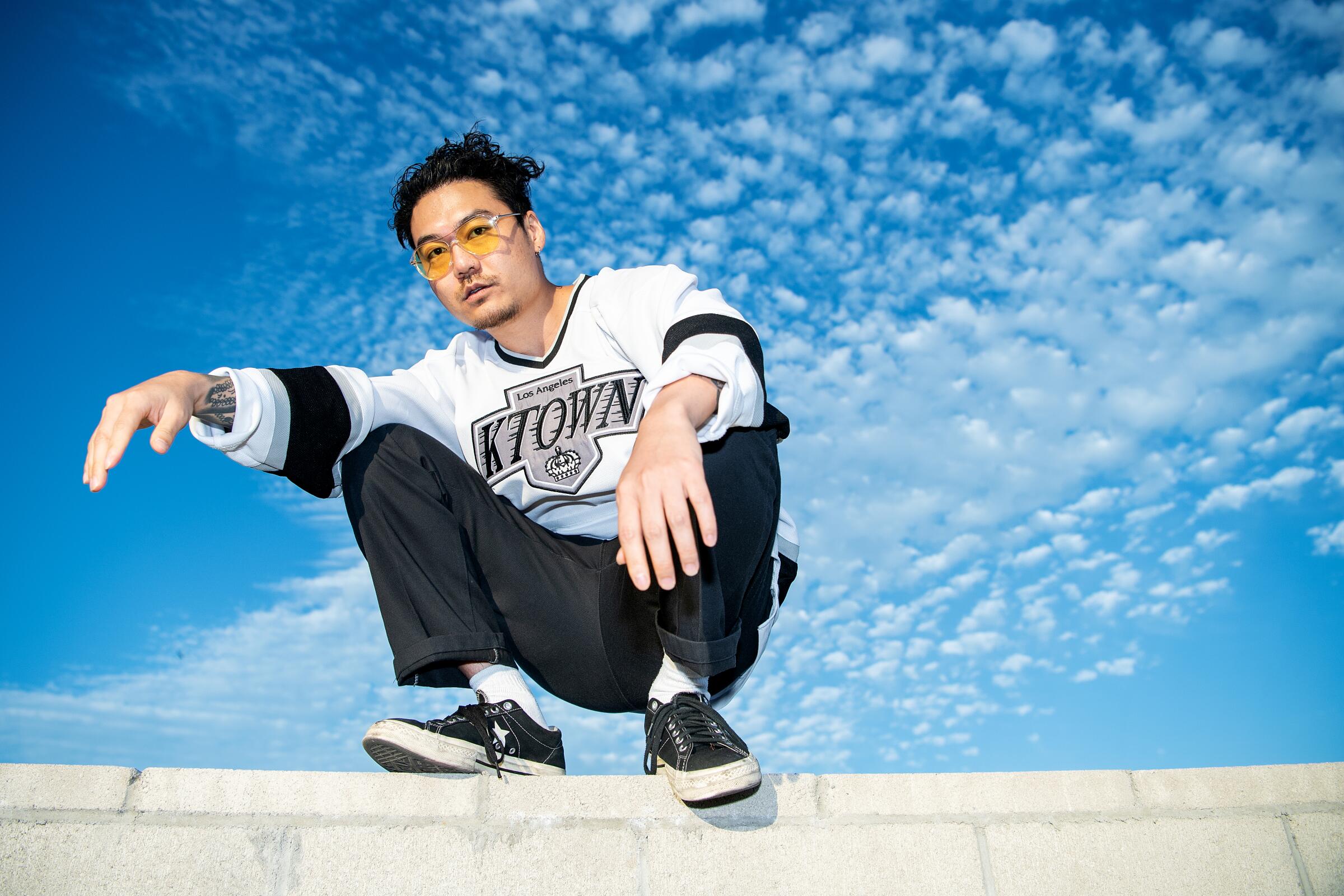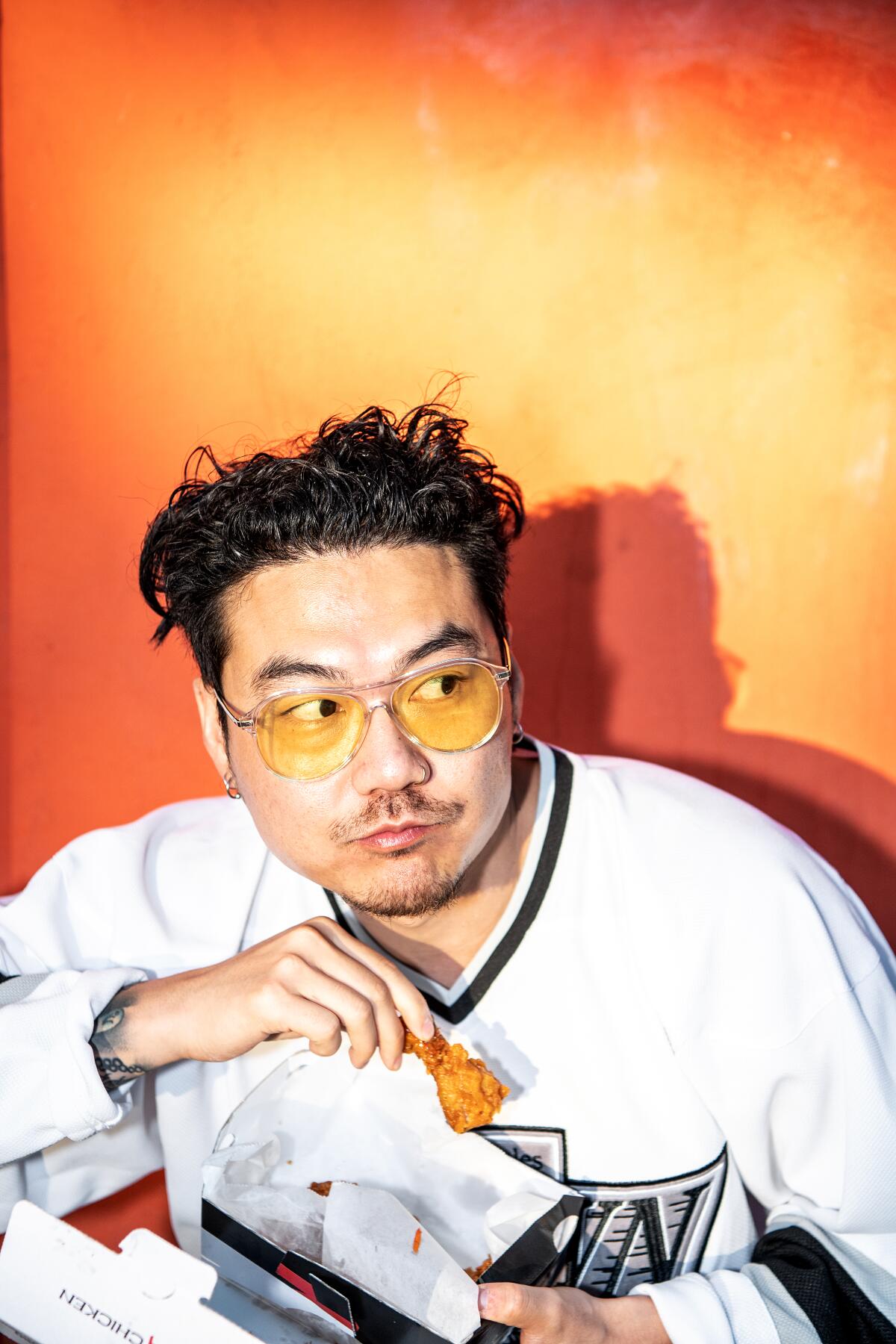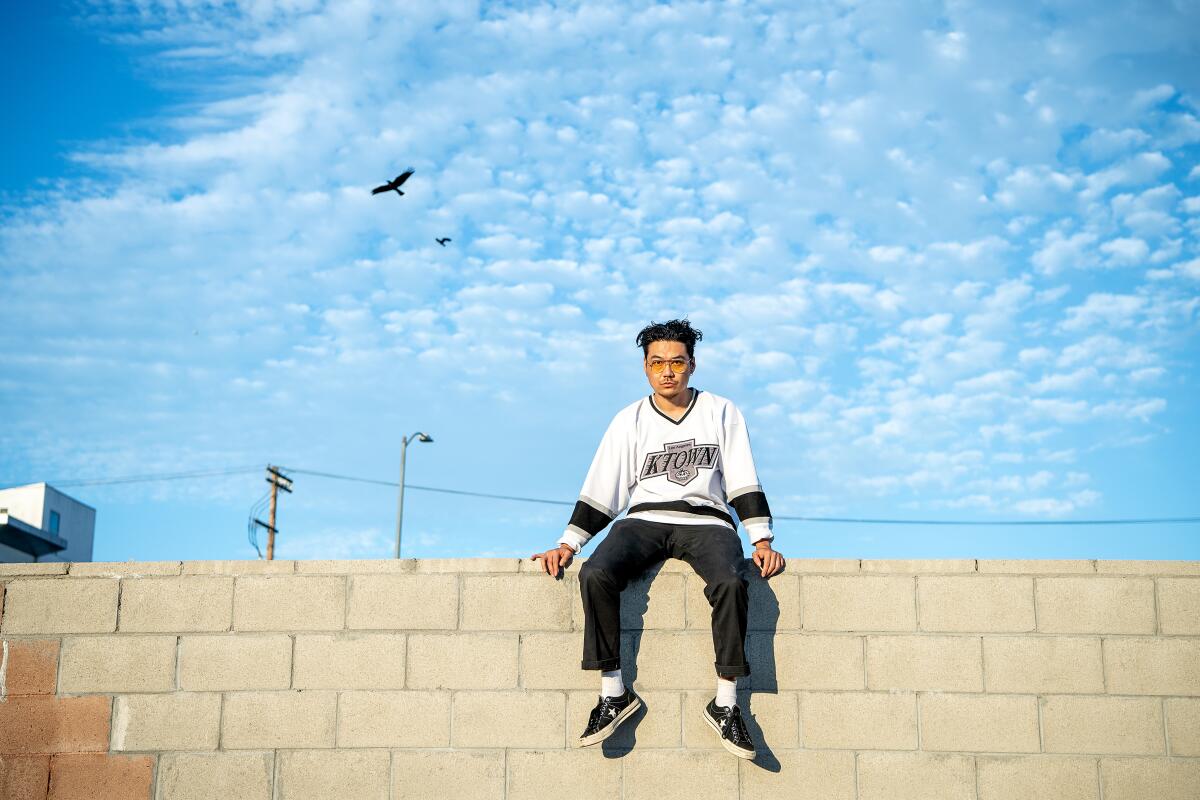Newsletter
Eat your way across L.A.
Get our weekly Tasting Notes newsletter for reviews, news and more.
You may occasionally receive promotional content from the Los Angeles Times.

For nearly three years, a mural of Jonathan Parkās face adorned a white wall outside Catalina Liquor in Koreatown, his home and the neighborhood heās become inseparably tied to as the rapper Dumbfoundead.
The artwork, a collage of thick and deliberate brushstrokes by L.A.-based artist Joseph Lee, was the backdrop to Parkās 2016 āMuralsā music video, in which he sports one of his signature merch items: a T-shirt styled in Los Angeles Dodgersā script that reads āKoreatownā and ā92,ā a reference to the civil unrest that scarred the community and shaped Southern Californiaās Korean diaspora.
But when Park learned taggers had scrawled over the mural last summer, he did not lament. He was grateful it had lasted longer than he had expected. It would not be repainted, he said. It was time for a new beginning.
These days, Park finds himself embarking on several new beginnings at once. Since he first gained notoriety as a battle rapper in the mid-aughts, heās carved out a successful career in hip-hop, putting out five studio albums and four EPs and touring extensively.
Heās also gained a foothold on TV and the big screen. He and friend Nora Lum ā whose rise as Awkwafina also spans mediums ā were featured in the 2016 film āBad Rap,ā a documentary following Asian American hip-hop artists. He followed that with a starring role in the 2017 battle-rap comedy/drama āBodied,ā directed by Joseph Kahn and produced by Eminem. Park also has a recurring role on Lumās Comedy Central show āAwkwafina Is Nora From Queens,ā which was renewed for a second season.
Recently, Parkās career has expanded into the food media world with a new First We Feast show that was made for and inspired by these pandemic times, āThe Takeout.ā In it, he orders food from restaurants for himself and his guest, whom he interviews over video chat.
āThis was actually very perfect for me, somebody who doesnāt know how to cook and who loves restaurant culture and eating out,ā Park said. āIāve been touring and stuff since I was young, so I jumped right into having a busy schedule and just getting something quick on the run, takeout, delivery, eating at restaurants.ā
So far on the show, Park has dined on kimchi jjigae, galbi jjim and haemul pajeon from Jun Won in Koreatown with Jay Park, the Seoul-based rapper who in 2017 became the first Asian American artist to sign with Jay-Zās entertainment agency, Roc Nation. He also has indulged in a chili-loaded meal from Original Tommyās with New York rapper Pardison Fontaine; galbi and a spread of banchan from Parkās BBQ with comedian Jo Koy; pasta from Stevieās Creole Cafe in Mid-Wilshire with Andy Milonakis; and jajangmyeon from Young King with actor-comedian Jimmy O. Yang.
āA lot of the places that Iām putting on the show are places Iāve been going for a long time,ā Park said. āNext thing I want to do is support one of my favorite Mexican spots.ā

The struggles of the industry arenāt lost on Park. Episodes open with a call to support restaurants during the pandemic while First We Feast flashes its support for the Restaurant Workersā Community Foundation, a nonprofit advocacy group that supports restaurant workers affected by COVID-19.
āRestaurants are establishments we celebrate in ā graduations, birthday parties or whatnot,ā Park said. āA lot of these places they literally ran on word-of-mouth. ā¦ They didnāt care about no advertising, nothing. Korean spots could have menus just in all Korean, and itāll still be popping daily.ā
Parkās pride in his home neighborhood is reflected in his work.
In April, it was announced that NBCās new digital subscription service Peacock had begun development on a comedy based on Parkās life, āBig Dummie.ā The show will be set in a diverse community thatās slowly gentrifying, much like Koreatown.
āI definitely wanted to incorporate the neighborhood that I come from, and what I mean to the neighborhood. And what the neighborhood means to me, how the neighborhood is changing for me, and how Iām changing to the neighborhood, as well,ā Park said. āItās just all around, change is happening.ā
Through his music, Park has been an ambassador of sorts for Koreatown.
āWhen I was touring, a lot of my merch items say āKoreatownā on it,ā Park said. āKids from Australia and Europe are copping it. I donāt even know if they know what Koreatown is.ā
More recently, Park has tried to be a unifying voice during a period of unrest and action.
The killing of George Floyd by Minneapolis police sparked a wave of nationwide protests against police brutality toward Black Americans. For Koreatown, when peaceful demonstrations sometimes flared into moments of destruction, the images of boarded-up windows stirred painful memories of Saigu, Korean for ā4/29.ā If just for a moment, it reminded some of the armed shop owners and workers perched on rooftops and in parking lots along Western Avenue 28 years ago.
The rooftop ahjussis engender a certain reverence. Many feel Koreatown was abandoned by Los Angeles police, and that these men armed themselves to protect their fledgling livelihoods and, by extension, their growing families.
But like his mural, Park doesnāt want this to be a lasting image of Koreatown.
āI feel like thereās a young generation of Korean Americans who saw those images, and they looked at these guys, they fetishized this hero-type of militant lifestyle of protecting your stores,ā he said. āI donāt think you should be images of fear, because all that does is divide.ā

Park, who helped Koreatown business owners board up their shops during the recent wave of protests, said heād like more āpeople at the pond,ā ready to engage and listen. That includes sending his mother translated guides to the Black Lives Matter movement and, later, mother and son marching on the streets of L.A. toward City Hall together, carrying signs that read āKoreans for Black Livesā and āI Canāt Breathe ģ ė°, ģØė§ķ.ā
āWe actually have the resources and knowledge to do more,ā he said.
Park shared some of the criticism heās received from within the community on social media.
āMe, as a Koreatown voice, Iām already getting grilled for it. Iāve been getting messages like Iām a ādisgrace to Asiansā and all that. But to me, I feel like this is the most responsible thing I can do as a leader, as opposed to create another divide and 28 years later be in the same situation with both communities,ā Park said.
Park said heās more comfortable with himself now than ever. Honesty and vulnerability are at the heart of his approach to life and work these days. That includes straight talk with his community, and how he views himself in his neighborhood.
āTo have longevity you gotta have growth, and youāre just not going to have growth when youāre stuck in a comfort zone,ā Park said.
āIf youāre really proud of a neighborhood you come from, you got to rep it outside of the neighborhood, not inside. To me, I was so Ktown ā so Ktown. Hip-hop really helped me think outside of my own community and see how I could really help my community from taking it outside the walls of Koreatown.ā
Eat your way across L.A.
Get our weekly Tasting Notes newsletter for reviews, news and more.
You may occasionally receive promotional content from the Los Angeles Times.